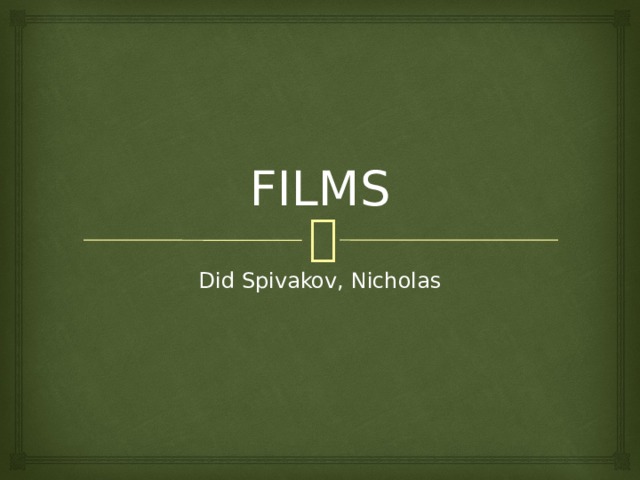
FILMS
Did Spivakov, Nicholas

content
- 1. Cinema appearance
- 2. The initial period of film development
- 3. Development of sound cinema
- 4. The development of color film
- 5. Latest trend
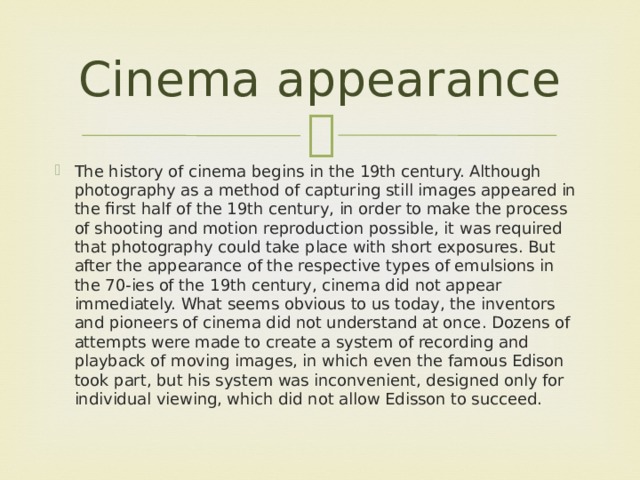
Cinema appearance
- The history of cinema begins in the 19th century. Although photography as a method of capturing still images appeared in the first half of the 19th century, in order to make the process of shooting and motion reproduction possible, it was required that photography could take place with short exposures. But after the appearance of the respective types of emulsions in the 70-ies of the 19th century, cinema did not appear immediately. What seems obvious to us today, the inventors and pioneers of cinema did not understand at once. Dozens of attempts were made to create a system of recording and playback of moving images, in which even the famous Edison took part, but his system was inconvenient, designed only for individual viewing, which did not allow Edisson to succeed.
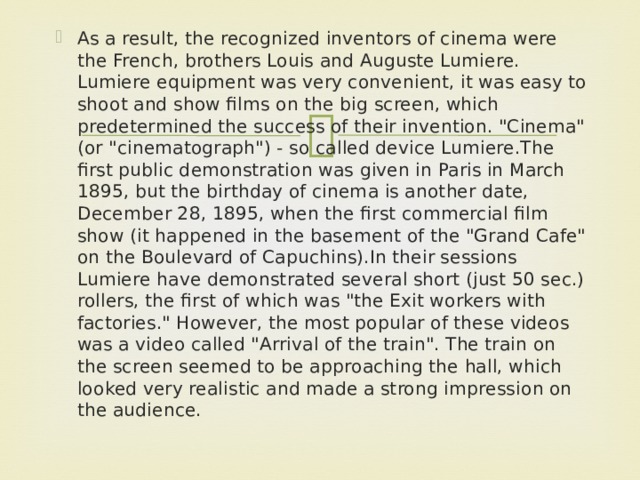
- As a result, the recognized inventors of cinema were the French, brothers Louis and Auguste Lumiere. Lumiere equipment was very convenient, it was easy to shoot and show films on the big screen, which predetermined the success of their invention. "Cinema" (or "cinematograph") - so called device Lumiere.The first public demonstration was given in Paris in March 1895, but the birthday of cinema is another date, December 28, 1895, when the first commercial film show (it happened in the basement of the "Grand Cafe" on the Boulevard of Capuchins).In their sessions Lumiere have demonstrated several short (just 50 sec.) rollers, the first of which was "the Exit workers with factories." However, the most popular of these videos was a video called "Arrival of the train". The train on the screen seemed to be approaching the hall, which looked very realistic and made a strong impression on the audience.
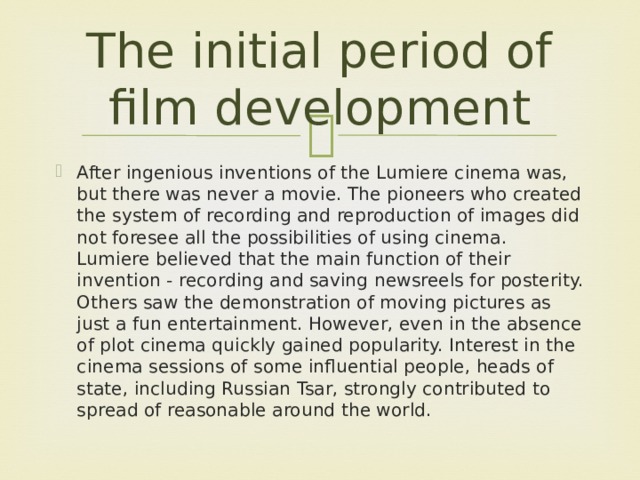
The initial period of film development
- After ingenious inventions of the Lumiere cinema was, but there was never a movie. The pioneers who created the system of recording and reproduction of images did not foresee all the possibilities of using cinema. Lumiere believed that the main function of their invention - recording and saving newsreels for posterity. Others saw the demonstration of moving pictures as just a fun entertainment. However, even in the absence of plot cinema quickly gained popularity. Interest in the cinema sessions of some influential people, heads of state, including Russian Tsar, strongly contributed to spread of reasonable around the world.
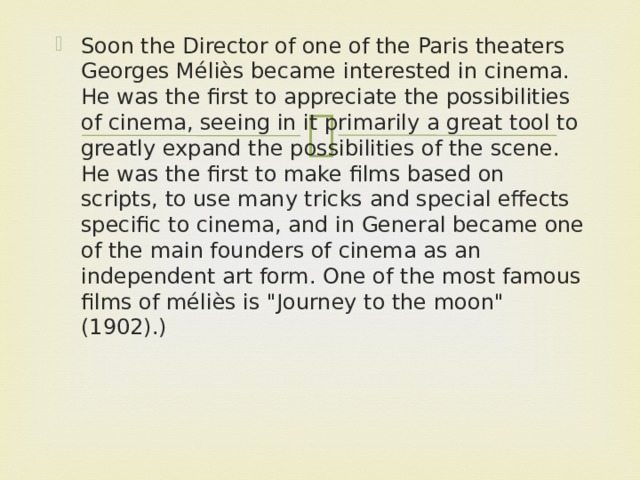
- Soon the Director of one of the Paris theaters Georges Méliès became interested in cinema. He was the first to appreciate the possibilities of cinema, seeing in it primarily a great tool to greatly expand the possibilities of the scene. He was the first to make films based on scripts, to use many tricks and special effects specific to cinema, and in General became one of the main founders of cinema as an independent art form. One of the most famous films of méliès is "Journey to the moon" (1902).)

- During the first decade of the 20th century the duration and variety of movie scenarios gradually and steadily increased. Society's attitude to cinema is changing - from the perception of it only as a form of entertainment to the perception of it as an art form. In 1908, in France there is the concept of "film d'art" - "art film".
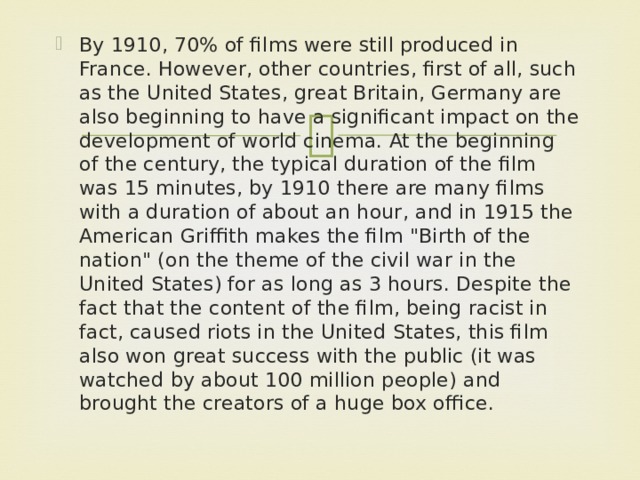
- By 1910, 70% of films were still produced in France. However, other countries, first of all, such as the United States, great Britain, Germany are also beginning to have a significant impact on the development of world cinema. At the beginning of the century, the typical duration of the film was 15 minutes, by 1910 there are many films with a duration of about an hour, and in 1915 the American Griffith makes the film "Birth of the nation" (on the theme of the civil war in the United States) for as long as 3 hours. Despite the fact that the content of the film, being racist in fact, caused riots in the United States, this film also won great success with the public (it was watched by about 100 million people) and brought the creators of a huge box office.
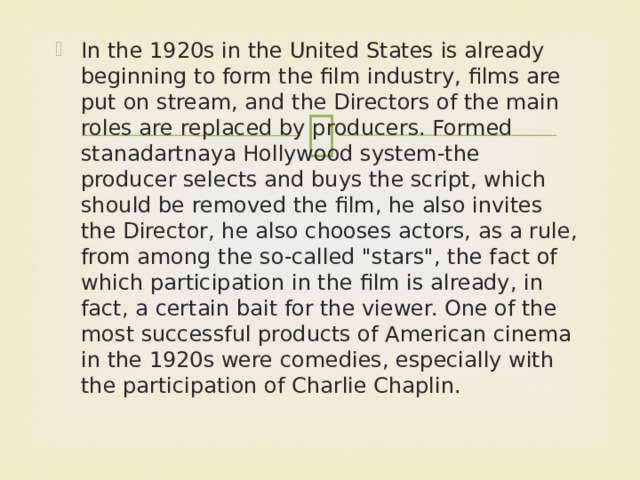
- In the 1920s in the United States is already beginning to form the film industry, films are put on stream, and the Directors of the main roles are replaced by producers. Formed stanadartnaya Hollywood system-the producer selects and buys the script, which should be removed the film, he also invites the Director, he also chooses actors, as a rule, from among the so-called "stars", the fact of which participation in the film is already, in fact, a certain bait for the viewer. One of the most successful products of American cinema in the 1920s were comedies, especially with the participation of Charlie Chaplin.
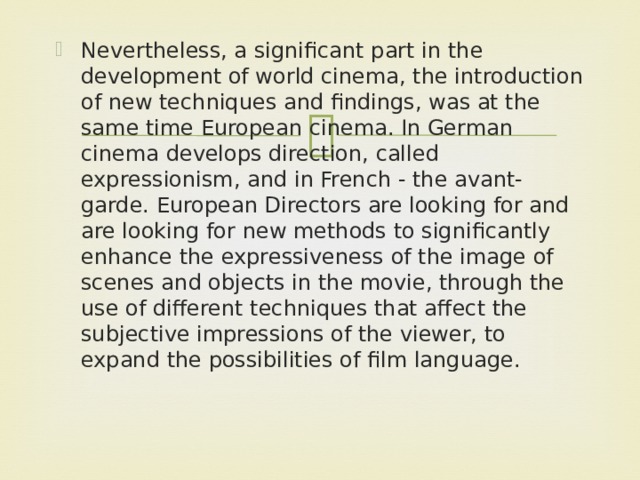
- Nevertheless, a significant part in the development of world cinema, the introduction of new techniques and findings, was at the same time European cinema. In German cinema develops direction, called expressionism, and in French - the avant-garde. European Directors are looking for and are looking for new methods to significantly enhance the expressiveness of the image of scenes and objects in the movie, through the use of different techniques that affect the subjective impressions of the viewer, to expand the possibilities of film language.
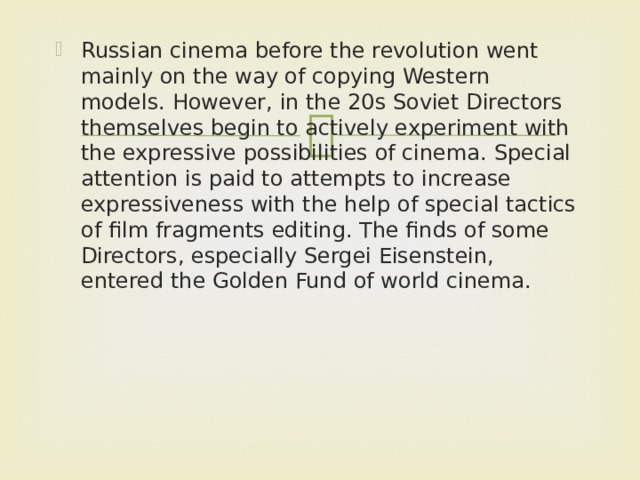
- Russian cinema before the revolution went mainly on the way of copying Western models. However, in the 20s Soviet Directors themselves begin to actively experiment with the expressive possibilities of cinema. Special attention is paid to attempts to increase expressiveness with the help of special tactics of film fragments editing. The finds of some Directors, especially Sergei Eisenstein, entered the Golden Fund of world cinema.
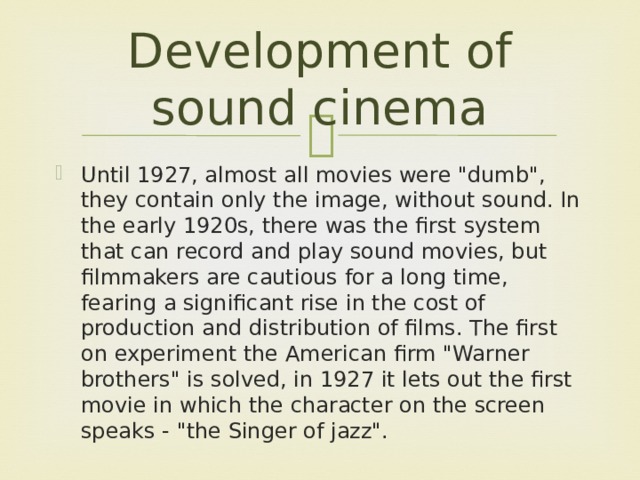
Development of sound cinema
- Until 1927, almost all movies were "dumb", they contain only the image, without sound. In the early 1920s, there was the first system that can record and play sound movies, but filmmakers are cautious for a long time, fearing a significant rise in the cost of production and distribution of films. The first on experiment the American firm "Warner brothers" is solved, in 1927 it lets out the first movie in which the character on the screen speaks - "the Singer of jazz".
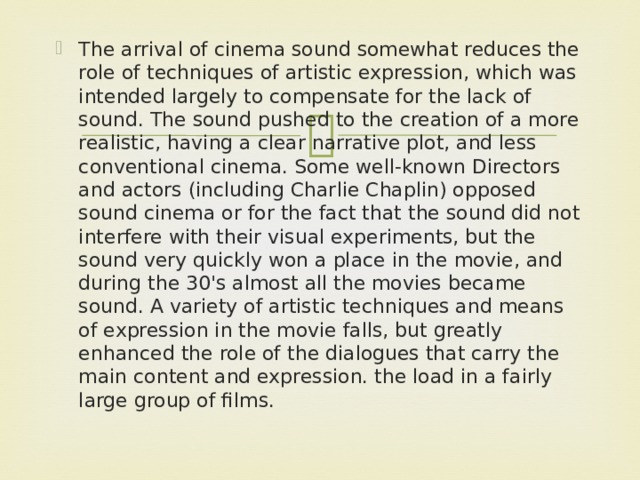
- The arrival of cinema sound somewhat reduces the role of techniques of artistic expression, which was intended largely to compensate for the lack of sound. The sound pushed to the creation of a more realistic, having a clear narrative plot, and less conventional cinema. Some well-known Directors and actors (including Charlie Chaplin) opposed sound cinema or for the fact that the sound did not interfere with their visual experiments, but the sound very quickly won a place in the movie, and during the 30's almost all the movies became sound. A variety of artistic techniques and means of expression in the movie falls, but greatly enhanced the role of the dialogues that carry the main content and expression. the load in a fairly large group of films.
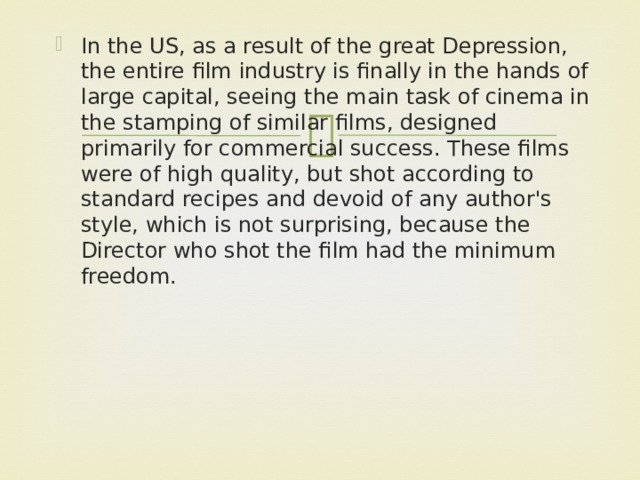
- In the US, as a result of the great Depression, the entire film industry is finally in the hands of large capital, seeing the main task of cinema in the stamping of similar films, designed primarily for commercial success. These films were of high quality, but shot according to standard recipes and devoid of any author's style, which is not surprising, because the Director who shot the film had the minimum freedom.
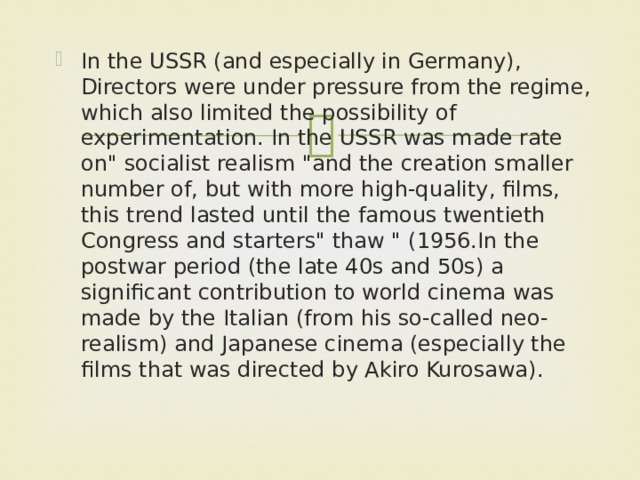
- In the USSR (and especially in Germany), Directors were under pressure from the regime, which also limited the possibility of experimentation. In the USSR was made rate on" socialist realism "and the creation smaller number of, but with more high-quality, films, this trend lasted until the famous twentieth Congress and starters" thaw " (1956.In the postwar period (the late 40s and 50s) a significant contribution to world cinema was made by the Italian (from his so-called neo-realism) and Japanese cinema (especially the films that was directed by Akiro Kurosawa).
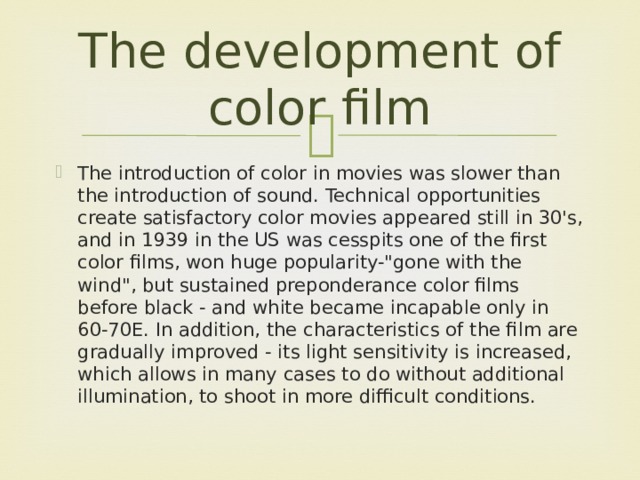
The development of color film
- The introduction of color in movies was slower than the introduction of sound. Technical opportunities create satisfactory color movies appeared still in 30's, and in 1939 in the US was cesspits one of the first color films, won huge popularity-"gone with the wind", but sustained preponderance color films before black - and white became incapable only in 60-70E. In addition, the characteristics of the film are gradually improved - its light sensitivity is increased, which allows in many cases to do without additional illumination, to shoot in more difficult conditions.
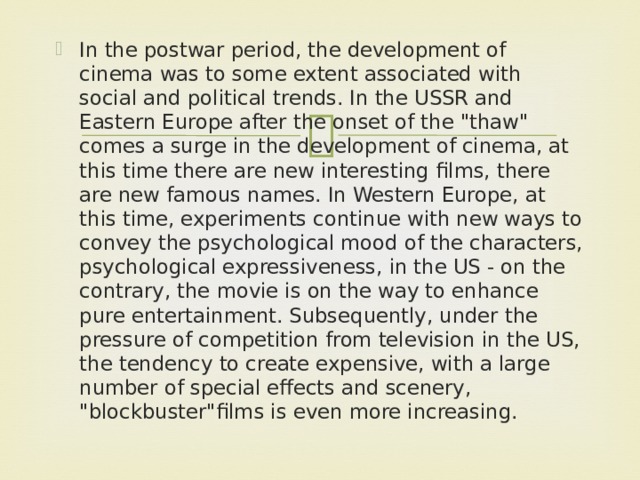
- In the postwar period, the development of cinema was to some extent associated with social and political trends. In the USSR and Eastern Europe after the onset of the "thaw" comes a surge in the development of cinema, at this time there are new interesting films, there are new famous names. In Western Europe, at this time, experiments continue with new ways to convey the psychological mood of the characters, psychological expressiveness, in the US - on the contrary, the movie is on the way to enhance pure entertainment. Subsequently, under the pressure of competition from television in the US, the tendency to create expensive, with a large number of special effects and scenery, "blockbuster"films is even more increasing.
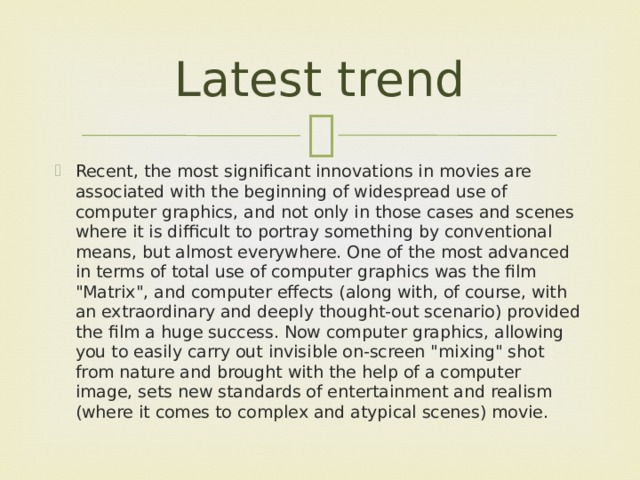
Latest trend
- Recent, the most significant innovations in movies are associated with the beginning of widespread use of computer graphics, and not only in those cases and scenes where it is difficult to portray something by conventional means, but almost everywhere. One of the most advanced in terms of total use of computer graphics was the film "Matrix", and computer effects (along with, of course, with an extraordinary and deeply thought-out scenario) provided the film a huge success. Now computer graphics, allowing you to easily carry out invisible on-screen "mixing" shot from nature and brought with the help of a computer image, sets new standards of entertainment and realism (where it comes to complex and atypical scenes) movie.

THANK YOU FOR LISTENING





